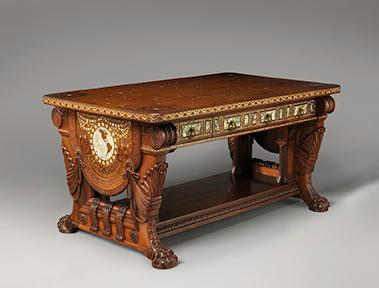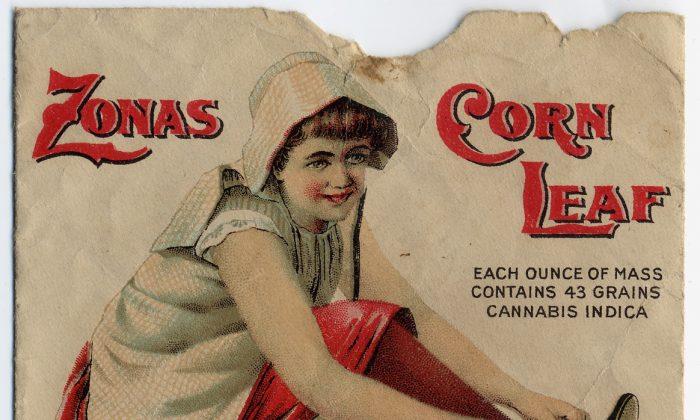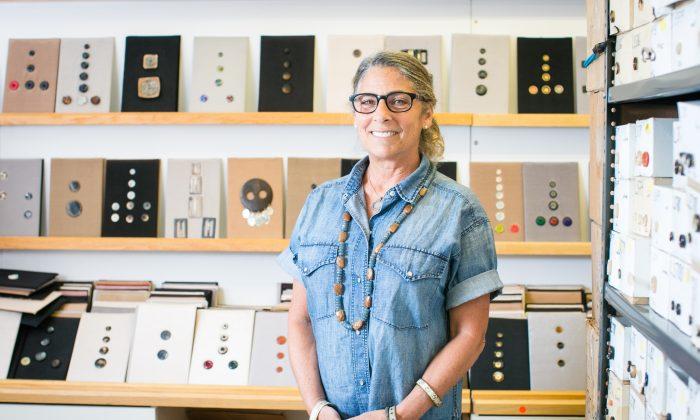Museums face this inescapable dilemma: for the sake of making works of art publicly accessible, the museum displays them de-contextualized from their cultural setting and functionality. Yet sometimes, museums such as the The Metropolitan Museum of Art (Met) will go to greater than usual lengths to give its visitors a more immersive experience. This is the pleasant case of a current Met exhibition: Artistic Furniture of the Gilded Age.
The exhibition evokes a time when America was being forged, when great fortunes were made, and the arts flourished.
Following the Civil War (1861–1865), the likes of railroad magnates William H. Vanderbilt (1821–1885) and Collis P. Huntington (1821–1900), as well as co-founder of the Standard Oil Company, John D. Rockefeller Sr. (1839–1937) had made enough money to afford more philanthropic pursuits.
They had amassed enough wealth to secure the livelihoods of their families for generations to come. At some point, faced with the inevitability of their own deaths, their thoughts had turned to immortality, history, legacy.
One could argue that the daily satisfaction of such great wealth is derived from seeing it in solid form, inhabiting it, being surrounded by beautiful objects. Often this meant building a great mansion from scratch, filling it with great art and lavish custom-made furniture that is a constant reminder of the fortuitous constellations smiling upon the moment of one’s birth. But more of the constellations later.
Such were the thoughts responsible for what is the subject of exhibition that marks the most opulent and never-to-be-repeated time in America, nicknamed The Gilded Age, when the arts flourished at an unprecedented speed, and American craftsmen excelled via the ready patronage of the great tycoons and, lest we forget, their better halves.
The Dressing Room
The centerpiece of the three-part exhibition is the opulent Worsham-Rockefeller dressing room from the New York City house commissioned by art collector and philanthropist Arabella Worsham (ca. 1850–1924) who married Collis P. Huntington (1821–1900) in 1884, after the death of his first wife.
The aesthetic movement in Europe had caught the attention of America. Here, no expenses were spared to create highly ornate interiors in a style that borrowed the proportions of Renaissance art and architecture, while adding copious amounts of Oriental-inspired decorations.
The effect can be overwhelming yet, due to the talent of New York-based cabinetmakers and interior decorators, the end results can be totally cohesive artistic interiors that leave one in total awe.
The Worsham–Rockefeller dressing room, the highlight of the exhibition, is a complete work of art, from floor to ceiling. It came from the house at 4 W. 54th St.—a brownstone building that was purchased by Arabella Worsham in 1877.
It was Worsham’s intimate space completely sheathed in satin-wood with inlay of purpleheart (amaranth) with a built-in wardrobe and matching furniture pieces featuring intricate marquetry ornamentation in satinwood and purpleheart with mother-of-pearl inlays. Its decorative motifs even reference Worsham’s great love of pearl jewelry, with garlands of necklaces, brooches and earrings, in the marquetry or the carved designs, as well as the frieze on canvas.

Many names had been bandied about as to who was the maker of the dressing room, but nobody knew exactly until the Met team of curators and researchers got to work and found the evidence. It turns out that in 1881 Worsham hired a decorator that had been used by Huntington—George A. Schastey (1839–1894)—to completely redo the interior spaces. As fate would have it, three years later she married Huntington, moved out and sold the house fully furnished and freshly decorated to John D. Rockefeller, hence the hyphenated name given to the room. It was donated to the Museum of the City of New York after Rockefeller’s death in 1937 and acquired by the Met in 2012.
“Schastey is the unsung hero and the star of the exhibition—previously, completely unknown. He’s clearly totally on par with Herter Brothers [working 1864–1906]– deemed the cabinetmaker at the time. And now Schastey is another one,” said exhibition organizer Alice Cooney Frelinghuysen, the Anthony W. and Lulu C. Wang curator of American Decorative Arts at the Met.
The exhibition has a few works by Schastey—all lavishly decorated and imposing. He is also the artisan responsible for another centerpiece in the exhibition, the Steinway grand piano, which is documented to have been delivered to Schasty in 1882 for the making of the art case.
The World Was My Oyster
An adjoining gallery has on display works by Schastey’s best-known competitor, Herter Brothers, which were created for the firm’s most important commission, the William H. Vanderbilt House. The centerpiece of this room is the grand rosewood table from the library of the William H. Vanderbilt house, which stood on Fifth Avenue and spanned a full city block.
Herter used decorative motifs in a Renaissance style that also recalled carved stone furniture of the Roman Empire. The lions’-paw feet and stylized palmettes framed views of the mother-of-pearl globes at each end. The seemingly random stars sprinkled on the top of the table represent the exact constellations visible in the Northern Hemisphere at the time of Vanderbilt’s birth—May 8, 1821. It is much more than a table. It exists to declare:,“The world is my oyster,” or rather, “The world was my oyster” to all who have the pleasure of casting their eyes on it.
In total, the exhibition includes around 40 examples of furniture from America’s Gilded Age found in the luxurious interiors of New York’s wealthiest households in the late 19th century.
“We feel that this is truly art furniture; it was conceived as art. It’s still functional but the textures, the colors, the designs, the workmanship that went into it–we are really making the case that this is museum quality, even though done for private residents,” said Nicholas C. Vincent, manager of Collections Planning and co-organizer of the exhibition.

While Vanderbilt and the other great men and women of the age did leave their mark through these glorious mementos of their opulent tastes, one is faced with the inescapable conclusion when admiring these works that these wealthy people were the mere custodians of their wealth. And while the cycle of life and death continues, their furniture is here to stay a little longer.
The exhibition is in three parts:
Artistic Furniture of the Gilded Age: Worsham–Rockefeller dressing room through to May 1, 2016.
Artistic Furniture of the Gilded Age: George A. Schastey through to May 1, 2016.
Artistic Furniture of the Gilded Age: Herter Brothers and the William H. Vanderbilt House through to Jan. 31, 2017.




